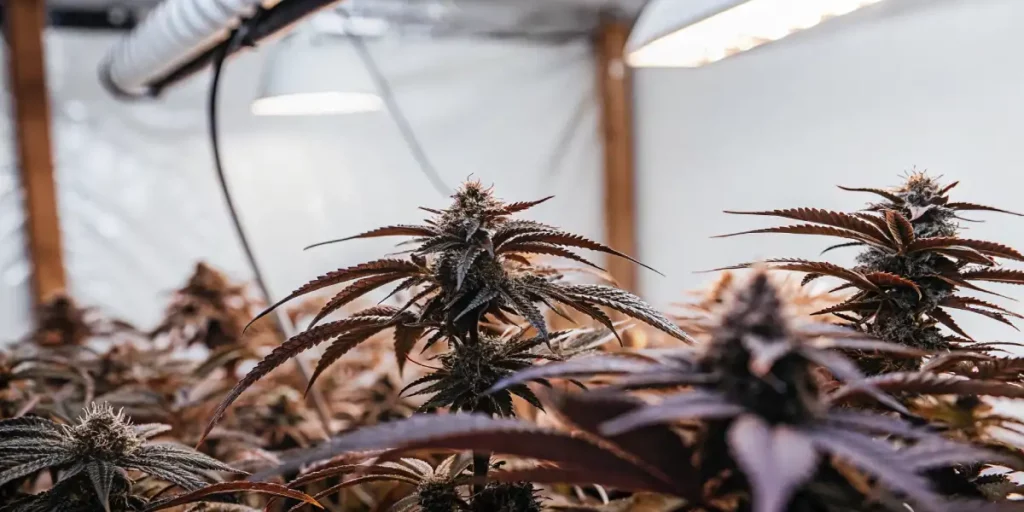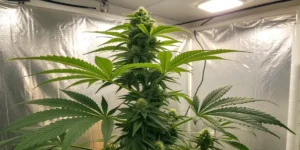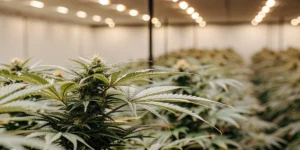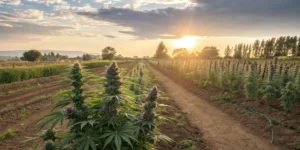Aquaponics cannabis cultivation combines aquaculture and hydroponics to create a symbiotic environment for growing cannabis. It’s an innovative method that appeals to both first-time cannabis seed buyers and seasoned growers. This sustainable system uses fish to produce natural nutrients for the plants, and in return, the plants filter and clean the water for the fish. This method reduces the need for chemical fertilizers and promotes organic growth.
Imagine a system where fish and plants thrive together. Fish like tilapia or goldfish are often chosen due to their hardiness and nutrient output. As the fish produce waste, beneficial bacteria convert it into nutrients the cannabis plants can absorb. In turn, the plants naturally clean the water, maintaining a healthy environment for the fish.
For those looking to cultivate cannabis sustainably, this method offers a unique approach. It’s not just about growing plants; it’s about creating a balanced ecosystem. Nutrient management is crucial, as the health of both plants and fish directly impacts each other. By closely monitoring this balance, growers can achieve impressive results without synthetic chemicals.
Benefits of Aquaponics Cannabis Growing Techniques
One of the main advantages of aquaponics cannabis growing techniques is sustainability. Traditional farming methods often rely on chemical fertilizers that can harm the environment. In contrast, an organic cannabis aquaponics setup uses natural processes to nourish plants. This not only benefits the environment but also ensures that the cannabis produced is chemical-free.
Another benefit is water efficiency. Aquaponics systems use up to 90% less water than traditional soil-based growing. This is because water circulates in a closed-loop system, minimizing waste. For cannabis growers, this means reduced water costs and a smaller ecological footprint.
Sustainable growing systems also provide a way to cultivate year-round, regardless of external weather conditions. This is particularly advantageous in regions with harsh climates, allowing growers to maintain consistent production levels. The controlled environment ensures that plants receive optimal conditions throughout their growth cycle.
Furthermore, these growing techniques encourage biodiversity. By integrating various species of fish and plants, systems can mimic natural ecosystems, promoting resilience against pests and diseases. This biodiversity can lead to healthier plants and more robust yields, enhancing the overall success of the cultivation process.
Setting Up Your Aquaponics Cannabis System
Setting up an aquaponics cannabis system involves a few key components. First, you’ll need a tank for the fish. The size of this tank will depend on how many plants you plan to grow. Next, you’ll need a grow bed for the cannabis plants, filled with a growing medium like clay pellets or gravel.
Water pumps are essential to keep the water circulating between the fish tank and the grow bed. This circulation is vital for transporting nutrients from the fish to the plants. A filtration system is also important to remove any solid waste and maintain water quality.
Choosing the right location for your setup is crucial. Ensure that your system is in a place where temperature and light can be controlled effectively. This will help in avoiding stress on the plants and fish, ensuring a more productive system.
Additionally, incorporating an automatic monitoring system can significantly ease the management of your aquaponics setup. By using sensors to track water quality and nutrient levels, you can make timely adjustments to maintain the balance needed for both fish and plant health. This proactive approach can prevent potential issues and optimize growth conditions.
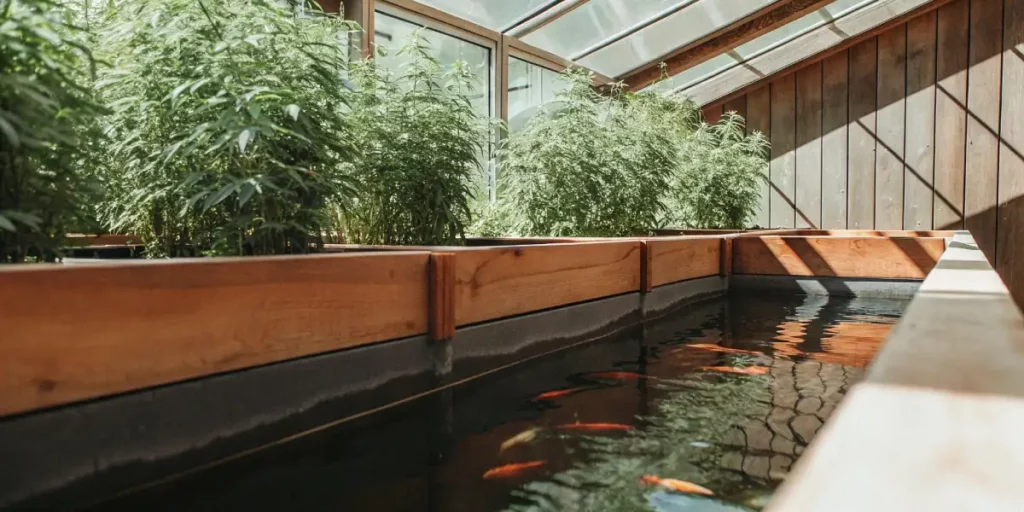
Choosing the Right Cannabis Strains
When it comes to selecting cannabis strains for aquaponics systems, it’s important to choose varieties that thrive in such an environment. Strains like Blue Dream and Northern Lights are popular choices. Blue Dream is known for its resilience and adaptability, making it ideal for beginners. Northern Lights, available at Global Green Genetics, is another strain praised for its robust growth and high yield.
Certain strains may require specific conditions, so always check the seed requirements. For instance, Purple Kush, also from Global Green Genetics, is a strain that flourishes in controlled environments, making it a great candidate for aquaponics cannabis systems.
Experimenting with different strains can be beneficial for growers using aquaponics systems. Some strains may offer unique benefits such as faster growth cycles or higher resistance to pests, which can enhance the efficiency and output of your setup. By diversifying the strains used, growers can discover new favorites that best suit their specific system.
In addition to choosing the right strains, understanding the specific nutrient needs of each variety is vital. Some strains may require higher levels of certain nutrients, necessitating adjustments in your nutrient management strategy. Tailoring the nutrient supply to match the needs of your chosen strains can ensure optimal growth and yield.
Maintaining Your Aquaponics System
Regular maintenance is key to a successful system. Start by monitoring water quality. Testing pH and nutrient levels ensures that the environment remains ideal for both fish and plants. Adjustments may be necessary based on test results.
Keep an eye on the fish. Happy, healthy fish contribute to robust plants. Feeding them a balanced diet and checking for signs of stress or illness can prevent issues before they affect your plants.
Another important aspect of maintenance is cleaning. Regularly check and clean the filtration and pump systems to ensure they function efficiently. This prevents blockages and ensures that the water circulation remains optimal for the health of both fish and plants.
Staying informed about the latest sustainable growing techniques can also aid in system maintenance. By keeping up-to-date with advancements and innovations in the field, growers can implement new strategies that enhance system performance and increase yield, ensuring a thriving ecosystem.
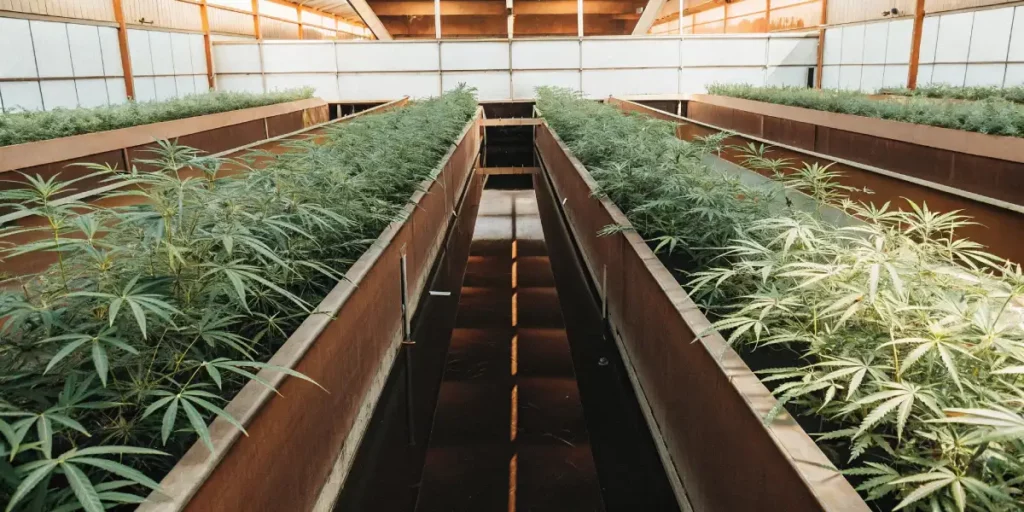
FAQs
What is aquaponics cannabis?
Aquaponics cannabis is a method of growing cannabis that combines aquaculture (raising fish) and hydroponics (growing plants in water without soil). This sustainable system uses fish to produce natural nutrients, which are then absorbed by the cannabis plants. The plants, in turn, filter and clean the water, creating a balanced ecosystem.
This method is attractive for those seeking a sustainable and organic approach to cannabis cultivation. By nurturing both fish and plants, growers can produce high-quality cannabis without the use of synthetic fertilizers or excessive water.
The appeal of this method lies in its ability to create a closed-loop system where resources are used efficiently and waste is minimized. This approach aligns with the growing trend towards eco-friendly and sustainable farming practices, making it a popular choice among environmentally conscious growers.
Furthermore, these systems can be scaled to fit various operational sizes, from small home-based setups to larger commercial operations. This flexibility allows growers at all levels to benefit from the advantages of aquaponics, tailoring their systems to meet specific production goals.
How does aquaponics cannabis nutrient management work?
Nutrient management in these systems involves maintaining a balance between the needs of the fish and the plants. Fish waste is converted by bacteria into nutrients that the plants can use. It’s important to monitor nutrient levels and water quality regularly to ensure both fish and plants remain healthy.
This balance can be achieved by testing the water for pH, ammonia, nitrite, and nitrate levels. Adjustments can then be made, such as changing feeding rates or adding supplements, to maintain optimal conditions for both components of the system.
Aquaponics cannabis nutrient management also involves understanding the life cycle of the plants. As cannabis plants grow, their nutrient requirements change, necessitating adjustments in the nutrient supply. Being attentive to these changes allows growers to optimize plant health and maximize yield.
In addition to managing nutrients, maintaining the right temperature and oxygen levels in the water is crucial. These factors can influence nutrient absorption and overall plant health. By ensuring these conditions are met, growers can support vigorous plant growth and robust fish health within their aquaponics system.
What are the best fish for aquaponics cannabis?
Tilapia and goldfish are commonly chosen as the best fish for aquaponics cannabis systems. Tilapia are hardy and produce a significant amount of waste, providing ample nutrients for the plants. Goldfish are also a good choice, particularly for smaller systems, as they are easy to care for and produce sufficient nutrients.
The choice of fish may depend on the size of your system and personal preference. It’s important to select fish that are compatible with your local climate and regulations. Proper care and feeding of the fish are essential for maintaining a healthy aquaponics system.
Besides to tilapia and goldfish, other fish species such as catfish and koi can also be considered for aquaponics systems. Each species has unique characteristics that may suit different system setups and grower preferences. Exploring various options allows growers to find the best fit for their specific needs.
Knowing the feeding habits and growth rates of selected fish species is also crucial. This knowledge helps in planning the system’s nutrient supply and ensuring that both fish and plants thrive. Proper integration of fish and plant needs is vital for the success of any aquaponics setup.
Can I grow any cannabis strain using aquaponics?
While many cannabis strains can be grown using aquaponics, some are better suited than others. Strains like Blue Dream and Northern Lights are known for their adaptability and resilience, making them ideal for this method. It’s important to choose strains that thrive in a controlled environment.
Always research the specific needs of the strain you choose. Factors like growth cycle, height, and nutrient requirements can affect how well a strain performs in an aquaponics system. By selecting compatible strains, you can maximize your chances of success.
Experimentation is key when selecting cannabis strains for aquaponics systems. Trying out different strains allows growers to identify which perform best under the specific conditions of their system. This process can lead to the discovery of new strains that yield better results and suit personal preferences.
Alongside strain selection, environmental control plays a significant role in the success of growing cannabis in aquaponics systems. Ensuring that temperature, humidity, and light are optimized for each strain will contribute to healthier plants and more abundant harvests.
What are the challenges of aquaponics cannabis systems?
One of the main challenges of aquaponics cannabis systems is maintaining the balance between fish and plant needs. Regular monitoring and adjustments are necessary to ensure both components of the system thrive. This can be time-consuming and requires some technical knowledge.
Another challenge is the initial setup cost. While aquaponics systems can save money in the long run, the cost of equipment and setup can be higher compared to traditional methods. However, the benefits of sustainability and high-quality organic cannabis often outweigh these challenges.
Overcoming technical challenges in these systems often involves a steep learning curve. New growers must familiarize themselves with both aquaculture and hydroponics principles to effectively manage their setup. Seeking advice from experienced aquaponics practitioners can provide valuable insights and guidance.
Additionally, maintaining such systems requires a commitment to ongoing education and adaptation. As technology and techniques evolve, staying informed about the latest advancements can help growers refine their methods and overcome any obstacles that arise, ensuring continued success in their sustainable growing endeavors.

